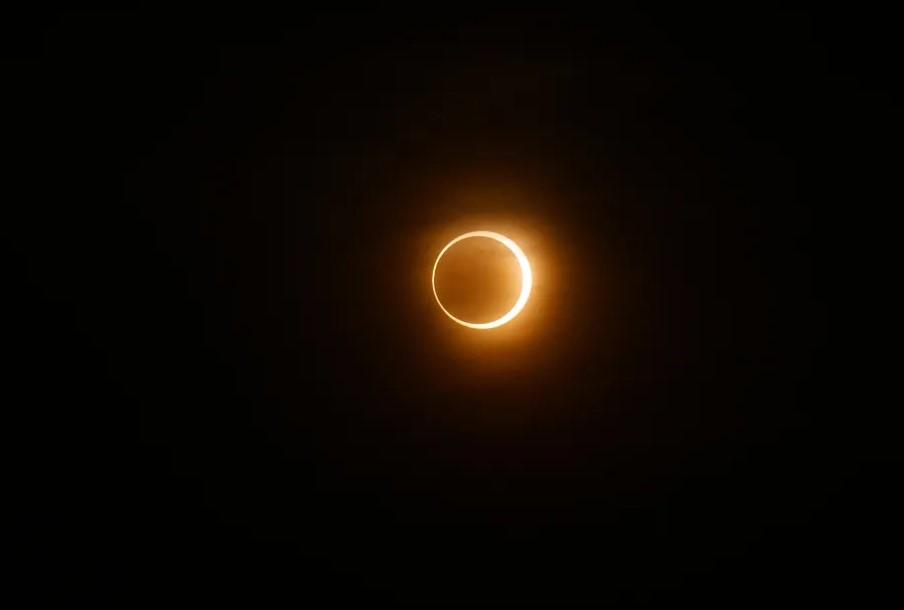A Rare 'Ring of Fire' Eclipse Occurs This Saturday

The moon will be squarely between the Earth and the sun on Saturday, October 14, causing a shadow to be thrown across the surface of the planet.
An annular "ring of fire" solar eclipse will be visible to anyone in the shadow's path, which is mostly the Western United States, Mexico, Central America, and South America.
The Navajo Nation and other Indigenous places in the Four Corners region, where these celestial occurrences have particular traditional importance, are notable stops on this weekend's route. Diné people who are Navajo Nation citizens are advised not to walk outside, gaze at the eclipse, or let the eclipse's light beam on them. In observance of traditional customs, certain tribal areas, such as the famous Monument Valley and all Navajo Tribal Parks, will be off-limits to tourists on Saturday. (A content caution for Diné readers: Below is a picture of a past annular eclipse.)
An annular eclipse is different from a total solar eclipse in that some light still peeks through the moon's borders. A total solar eclipse occurs when the moon completely obscures the sun.
This is due to the fact that annular eclipses happen when the moon is somewhat farther from Earth than it is in its orbit. Because of this extra distance, the moon seems to be somewhat smaller than the sun, which permits a brilliant halo to surround it.
This is the origin of the term "ring of fire." This is how these eclipses appear. Nice, huh? (However, avoid looking straight into it). Here's more about that.) It's a really uncommon sight. This decade will only see 12 additional annular eclipses, distributed all around the world.
NASA reports that regions of Oregon, California, Idaho, Nevada, Utah, New Mexico, Texas, Colorado, and Arizona will be able to see the eclipse, weather permitting.
The eclipse will traverse through Mexico, Belize, Honduras, Nicaragua, and finally reach Brazil. It will start in Oregon at 9:13 a.m. Pacific Time and terminate in Texas at 12:03 p.m. Central Time.
For details on when the eclipse will pass over your region of the United States, see the map below. Only those who are in the darkened area may view the entire fire ring.
Visit NASA's eclipse website instead; it has a cool interactive element. You may click anywhere along the eclipse's path on their page to receive specific times for when the sky show starts and concludes where you are.
NASA will transmit a live feed of the eclipse for anybody who are unable to go to the eclipse's path. Watch that down below.
And if you're still asking "Why and how do solar eclipses happen?" after reading this far, and "When is the next one going to be?" and "How can I watch this without burning out my eyes?," you're in luck:
Why do solar eclipses occur?
The explanation is straightforward: Occasionally, when the moon moves across the sky, it obscures the sun. However, it goes beyond that. The shadow can only arise when three cosmic requirements are satisfied.
1) The moon needs to be fresh.
Although the illuminated side of the moon isn't constantly facing Earth, it is always illuminated by the sun. This is how the moon's phases are obtained. A solar eclipse can only happen while the moon is in its "new moon" phase.
The dark side of the moon faces Earth directly during the new moon.
2) The lunar orbit must traverse the Earth's orbital plane.
Why aren't solar eclipses happening every new moon if the dark side of the moon must be facing Earth? This is a result of the moon's orbit not exactly matching that of the Earth.
This is a result of the moon's 5-degree tilt. Although the exact source of the moon's minor skewness is unknown, it is thought to have resulted from a big object colliding with Earth during its formation.
This indicates that the shadow usually passes across Earth during new moons.
However, the moon's orbit has two locations where the shadow might fall on Earth. We refer to them as nodes.